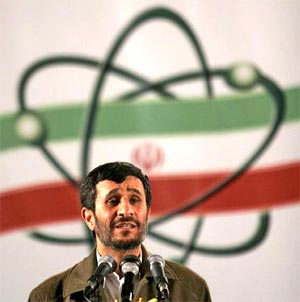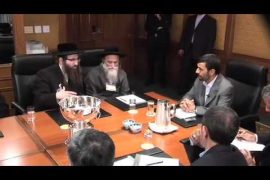A guest post by Gidon Ben-Zvi, an Anglo-Israeli freelance writer
 As the Guardian’s Julian Borger recently reported (Iran nuclear talks: Settling for confusion in Baghdad, hoping for clarity in Moscow, May 29th) Iran and six of the world’s major powers agreed to settle on confusion at the latest round of negotiations in Baghdad and which adjourned on May 24th with no sign of progress.
As the Guardian’s Julian Borger recently reported (Iran nuclear talks: Settling for confusion in Baghdad, hoping for clarity in Moscow, May 29th) Iran and six of the world’s major powers agreed to settle on confusion at the latest round of negotiations in Baghdad and which adjourned on May 24th with no sign of progress.
The focal point of the talks was the international community’s call on Tehran to stop enriching uranium to 20 percent purity, which is a short technical step away from highly enriched uranium that can be weaponized.
The Iranians have responded with calls of their own for an immediate easing of the increasingly painful economic sanctions which have been imposed on them.
And so the endless whirling diplomatic pirouette continues; accompanied as always by rosy prognostications, fervent wishes and dramatic – albeit brief – flowerings of optimism. How long have Iranian and Western diplomats been filling their dance cards with high level quibbling on the issue of Tehran’s nuclear program? Here’s a cursory list of U.N. sanctions leveled against the Islamic Republic of Iran:
- United Nations Security Council Resolution 1696 – passed on July 31, 2006. It demanded that Iran suspend all enrichment-related and reprocessing activities, invoking Chapter VII of the UN Charter, but did not impose sanctions.
- United Nations Security Council Resolution 1737 – passed on December 23, 2006. It banned the supply of nuclear-related materials and technology and froze the assets of key individuals and companies related to the program.
- United Nations Security Council Resolution 1747 – passed on March 24, 2007. It imposed an arms embargo and expanded the freeze on Iranian assets.
- United Nations Security Council Resolution 1803 – passed on March 3, 2008. It extended the asset freezes and called upon states to monitor the activities of Iranian banks, inspect Iranian ships and aircraft, and to monitor the movement of individuals involved with the program through their territory.
- United Nations Security Council Resolution 1835 – passed on September 27, 2008.
- United Nations Security Council Resolution 1929 – passed on June 9 2010. It banned Iran from participating in any activities related to ballistic missiles, tightened the arms embargo, and recommended that states inspect Iranian cargo, prevent the provision of financial services used for sensitive nuclear activities and closely watch Iranian individuals and entities when dealing with them…
It’s a wonder of modern day statecraft that such bold resolutions haven’t managed to persuade Mahmoud Ahmadinejad and his Mullah regime to give up their pursuit and development of the bomb.
And the short list above doesn’t include the bilateral sanctions leveled by the European Union, United States and other countries against Iran.
Fortunately, U.S. President Barack Obama has reacted to Tehran’s repeated evasions regarding nuclear weaponization with strong talk, saying that the world is “unified around Iran’s misbehavior in this area.”
Date of quote: February 9, 2010.
Two years later, on March 14, 2012, Obama again unsheathed the proverbial saber and gave it a good rattle, stating that that the window for dealing with its nuclear program through diplomatic channels is “shrinking.”
Albert Einstein once said that insanity can be defined as “doing the same thing over and over again and expecting different results.” As such, is Yukiya Amano, the Director General of the International Atomic Energy Agency, just slightly mentally deficient? Perish the thought. Rather, the meat and marrow of any deal is, unfortunately, secondary to the political spinning at play whenever a perceived breakthrough on inspections is proclaimed.
If the true goal of these talks is to resolve the polarizing issue of Iran’s nuclear program in one of the world’s most volatile regions – and not to simply claim faint diplomatic victories that usually revolve around the tortured cliché of “agreeing to keep talking” – Iran’s race to convert enriched uranium to bomb-grade fuel can be significantly slowed in a number of ways. While the country is already nuclear capable, a nuclear-armed Iran is not inevitable.
In general a concerted, synchronized implementation of the following policies could help prevent Iran from crossing the line from weapons capability to weapons production: Containment, Deterrence, Intrusive Inspections and Engagement (since the main purpose of the first three courses of action is to persuade Iran to negotiate).
Should these diplomatic overtures fail there’s the option of using military force to halt or reverse nuclear proliferation. Since Israel has more to fear from a nuclear Iran than the United States, it may need to resort to force to curtail Iran’s capabilities if diplomacy fails. The Israeli Air force possesses the capability to destroy even well-hardened targets in Iran with some degree of confidence.
Possible attack routes include flying over the Mediterranean, refueling from airborne tankers and then continuing east over Turkey to Iran, or having IAF planes fly southeast, over Jordan and Saudi Arabia, and then continuing northeast across Iraq. A third option would involve Israeli forces flying southeast and then east along the Saudi-Iraqi border to the Persian Gulf and then north, refueling along the way.
To resolve this crisis diplomatically, Tehran will need to be convinced of Western resolve to halt its nuclear program. Such a breakthrough will only occur as a result of tougher sanctions and stiffer demands than those presented in the two rounds of talks conducted Baghdad. While a diplomatic, peaceful resolution is ideal, it may not be achievable in light of the Iranian people’s — reformers and conservatives alike — strong support for enrichment.
National pride in the technical prowess embodied in Iran’s nuclear program is at the core of this support.
For now, the dance continues. The third attempt in three months to answer international worries that Iran’s atomic energy program may be a cover for secret weapons work is scheduled to take place next month in Moscow.
How appropriate that the next round of graceful, flowing, ethereal diplomatic doublespeak that aims to bring us “peace in our time” will be held at the home of the Bolshoi Ballet.
Related articles
- With Iran, keep your eye on the bomb (blogs.timesofisrael.com)



